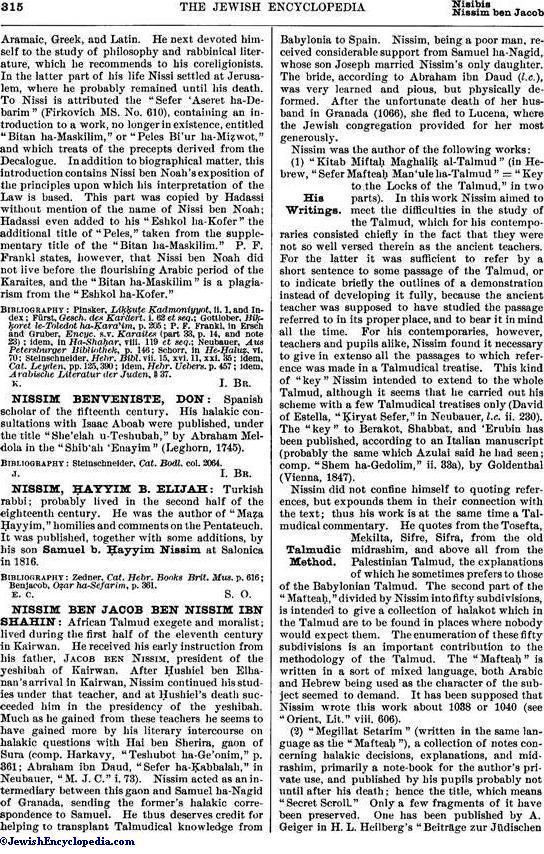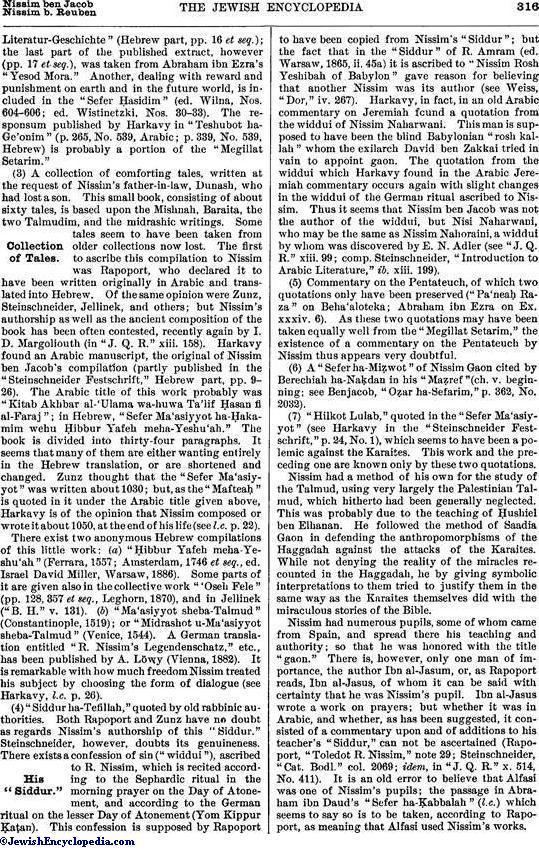Name Nissim Jacob Role Rabbi | ||
 | ||
Books An Elegant Composition Concerning Relief After Adversity Similar People Isaac Alfasi, Samuel ibn Naghrillah, Salomon Buber | ||
Nissim ben Jacob (Hebrew: ניסים בן יעקב, also known as Rav Nissim Gaon or in Hebrew: רבנו נסים, lit. Nissim our teacher; 990–1062), was a rabbi best known today for his Talmudic commentary ha-Mafteach, by which title he is also known.
Contents

Biography
Rav Nissim studied at the Kairouan yeshiva, initially under his father - Jacob ben Nissim ("Rav Yaakov Gaon") who had studied under Hai Gaon - and then under Chushiel, whom he succeeded as head of the Yeshiva. Nissim himself later became head of the yeshiva; in this capacity he is closely associated with Chananel son of Chushiel. His most famous student is probably Isaac Alfasi (the "Rif"). Rav Nissim maintained an active correspondence with Hai Gaon and with Shmuel Hanaggid, whose son Joseph married Nissim's only daughter (1049 CE). As the former was in Bavel (Babylonia) and the latter was in Saferad ("Spain"), Rav Nissim is also credited with having maintained through his letters the lines of Rabbinic discourse between these easternmost and westernmost Jewish communities.
Works
The commentary Sefer Mafteach Man'ulei Hatalmud (Hebrew: "The book of the key to the Talmud"; often, simply ha-Mafteach, (The Key), linked here) is essentially a Talmudic cross-reference. In it Rav Nissim identifies the sources for Mishnaic quotes, identifying obscure allusions to other places in Talmudic literature. He quotes from the Tosefta, Mekhilta, Sifre, Sifra, and from the Jerusalem Talmud, the explanations of which he sometimes prefers to those of the Babylonian Talmud. Nissim did not confine himself to quoting references, he also discusses these in connection with the text; this work is thus also a commentary. The work was written on several tractates, and is printed, in many editions, on the page itself.
Nissim also wrote other works, some of which have been lost, but which are quoted by later sages:
Literary portrayals
R. Nissim appears as a character in A Delightful Compendium of Consolation: A Fabulous Tale of Romance, Adventure and Faith in the Medieval Mediterranean, a novel by Burton Visotzky. The novel expands on the few known biographical facts (including the marriage of his daughter). Its title, A Delightful Compendium, derives from "Ḥibbur Yafeh".
